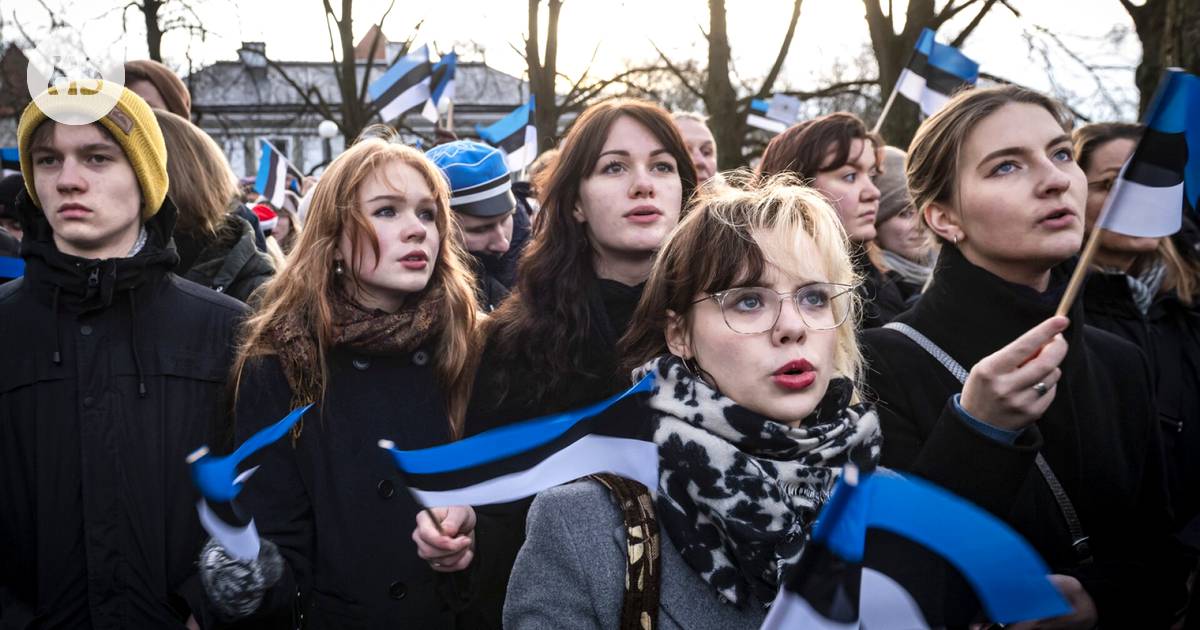The Estonian Independence Day flag raising has become a mass event that draws young people to the hill. “Nationalism is a positive thing, but being Estonian is also politically incorrect,” say the high school students.
Is Saturday, but high school students' alarm bells are ringing in different parts of Tallinn: Jürgen Iilan the clock rings 05:00 and Taavi Ambren a little later in the Nõmme district, Mariann Kullamäki 05.10 in the suburb of Lasnamäki and by Mirjam Root on the pirita, Mia Aurelia Cook 05.20 in Kalamaja, Saara Mette Vahterin 05:30 in the center.
Last year, six friends went together to watch the flag raising on the morning of Estonian Independence Day, and this year they decided to go again.
The day of celebration begins before sunrise in Tallinn's old town.
Meeting is at 07:15 in the old town by the Town Hall. The girls have long coats. Everyone makes it on time except Iila, who has the longest journey to the place.
The route takes a narrow alley up the hill and to the gate of the Governor's Park, which is crowded with people.
There are more people than the 0.4 hectare park can stand side by side, an estimated couple of thousand. There are leading politicians, school flag guards, student organizations. The majority of the audience is middle-aged or young. Jürgen Iila does not stand out from the crowd.
The flag-raising on the morning of Estonia's independence day has turned into a mass event, the more aggressive Russia has been towards its border neighbors.
The group clears a place in the crowd, from which there is a view up to the top of Pitkäni Hermann's tower, which is almost 50 meters high.
The flag-raising on the morning of Estonian Independence Day, February 24, has turned into a mass event.
Miriam Root
Saara Mette Vahter
“Ticket”comes a whisper.
At 7:35 a.m., the flag rises into the air at the top of the tower.
The orchestra starts playing the anthem “Mu isamaa” with the same by Friedrich Pacius a note like in our Maamme song. Saara Mette Vahter and Mirjam Root have tears in their eyes.
Because of this moment, people are on the hill on Estonian Independence Day, February 24, at sunrise.
“It's a great feeling,” says Mia Aurelia Kokk.
“Everyone is together for a common cause,” adds Vahter.
“Cold shivers rise whenever patriotic songs are sung,” says Mirjam Root.
Mia Aurelia Kokk (left) and Mariann Kullamäe greet Jürgen Iila after the flag raising.
The continuation of the ticket collection will be at Saara Mette Vahteri's home in the center of Tallinn.
Jürgen Iila baked the cheese ham pies the night before.
Ticket collection the continuations are at Vahter's home in the city center.
Jürgen Iila takes his baked ham and cheese pies from the Pikku Myy bag, Mia Aurelia the cook measures oatmeal for porridge, Mirjam Root cuts a tomato in the kitchen.
Is nationalism mainly a positive phenomenon or is there also something negative associated with it?
“It's positive,” says Iila.
Iila has a hoodie from the international exchange student organization Yfu. He has been an exchange student in Ireland and enjoys going to the gym.
“Hitler's Germany has been talked about in history classes. In that context, nationalism is really bad, but not in Estonia,” says Kokk.
The comparison with Hitler's Germany makes others laugh. Estonia does not dream of becoming the ruler of the world, and therefore the party does not see anything negative in nationalism.
“The fact that we want our own state is reasonable and limited,” says Mariann Kullamäe.
Kokk says that he once knew 13-14-year-old boys who thought that all refugees should be sent out of the country. But they hardly thought so, he estimated.
“Even though there are people in Estonia who think like that,” says Mirjam Root.
However, people living in the country should study the Estonian language. The party agrees with this.
Mariann Kullamäe lives in the suburb of Lasnamäki in an apartment building, of which only two of the 60 apartments have an Estonian-speaking family. On grandma's advice, she greets them in Estonian. Still, the neighbors often answer in Russian.
Kullamäe says that he stopped studying Russian after elementary school:
“I don't feel it's my duty.”
Kokk, Vahter and Root made an “Eyewitness” broadcast during the school's Estonian class about how a Russian-speaking school in Tallinn views changing the language of instruction to Estonian by the end of the decade.
“Fortunately, the majority reacted positively. The only problem is finding teachers,” says Kokk.
Young people have encountered a language barrier in taxis, with food deliveries and even at the doctor's office.
The milk boils gently.
“Oh my god!”
The milk was forgotten to boil.
Oatmeal is ready.
Oatmeal is ready.
Raising the flag and being Estonian in general has become more relevant since Russia seized Crimea and the war in eastern Ukraine began.
When Russia invaded Crimea in Ukraine ten years ago, Kokk was in the first grade and in the village with his friend's grandmother. He said that now the war is starting in Estonia as well.
“It brought tears to my eyes.”
Then Russia launched a major offensive.
“Now the third year begins. Every day is a little fear. You never know what will be in the news,” says Kokk.
At the beginning of the great attack, Saara Vahter was traveling in western France. The mother sent her the contact information of a friend who lives in Vienna in case the daughter could not return to Estonia. In France, acquaintances did not have the same concern.
“I realized that there are many countries whose inhabitants never think about what if someone attacks,” says Vahter.
Kilohaili sandwich is the traditional food of Estonia's Independence Day. Mia Aurelia Kokki liked it, but not the whole party.
On the table is Estonian black bread with butter and cold meats or with mayonnaise and kilo hake. The porridge is topped with homemade rhubarb-strawberry jam. There is fat milk in a two liter can.
In just a few years, people from all over the world have moved to Tallinn. Is internationality mainly positive or are there negative phenomena associated with it?
“It is positive and negative. The Estonian customs of St. Martin's and St. Catherine's Day have been overshadowed by Halloween, when American culture comes over,” says Mirjam Root.
Kokk himself started speaking English with his schoolmates when he was around 11-12 years old. When he learned the language for real, he stopped.
“Every language has its place,” he says.
The chef has noticed that being Estonian is not that important to his ten-year-old little brother. He thinks that he could start teaching his brother to be Estonian little by little. It could even start with showing Stupid people– i.e. the Ilonpilajaa program.
Tujirikku was a comedy show that made fun of everything from mass deportations of Estonians to Siberia and death.
“You couldn't imagine that in other cultures,” Kullamäe says.
According to the group, Estonianness also includes humor, where “there is no political correctness whatsoever”.
However, on Independence Day, young people plan to watch a film about the Estonian War of Independence of 1918-20 Named marble tablets, Names on a marble tablet. It tells about schoolchildren who decided to go to war against the Red Army.
In the middle of the dining table is a miniature flag that Saara Mette Vahter's mother bought in 1988 when she was young. Then the Estonians brought out their flag after a long time without fear of punishment.
“I imagine that the atmosphere of the flag raising is similar to that during the singing revolution,” says Mirjam Root.
The people's movement, which in the 1980s led to the restoration of Estonia's independence and the dissolution of the Soviet Union, is called the singing revolution. People got more freedoms and borders opened. The driving mass force was nationalism.
In everyday life the meaning of independence is conveyed unnoticed in the speeches of teachers and parents, when they reflect on their own youth.
“For example, we eat breakfast and I ask for a sausage. Grandma might sigh, listen kids, we didn't have sausage in our childhood,” says Kokk.
The saying of some older teachers has stuck in my ears: “You were born in free Estonia. Of course you don't understand.”
Jürgen Iila says that while walking in the old town, his mother remembers how as a child she ran to the ice cream line, because otherwise she would have missed out.
“They reminisce about the same things with nostalgia, which to us sounds like a dystopia,” says Iila.
“How I fought in the grocery store to get a curd bar,” Iila adds.
Vahter says that during her mother's school days, they practiced putting on gas masks and the teacher took time to see how quickly she could disassemble and assemble the Russian assault rifle Kalashnikov.
Kokk has heard from his father that, as a conscript in the gas attack department of the Soviet Army, he greased bread with shoe polish when there was no butter.
Everyone laughs.
The high school students laughed at the stories they had heard from their parents during the Soviet occupation.
#Estonia #Young #Estonians #wake #time #rooster #crowing #order #celebrate #National #Day








